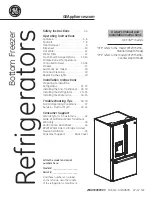
10
10
10
IMPORTANT:
■
Give your refrigerator time to cool down completely before
adding food. It is best to wait 24 hours before you put food
into the refrigerator.
NOTE: Adjusting the Temperature control to a higher (colder)
setting will not cool the compartments any faster.
■
If you add food before the refrigerator has cooled completely,
your food may spoil.
Adjust the Temperature Control
The mid-settings should be correct for normal household usage.
The controls are set correctly when milk or juice is as cold as you
like and ice cream is firm.
If the temperature is too warm or too cold in the refrigerator or
freezer, first check the air vents to be sure they are not blocked.
If you need to adjust temperatures, use the settings listed in the
chart below as a guide. On models with two controls, adjust the
refrigerator temperature first. Wait at least 24 hours between
adjustments and then recheck the temperatures.
Airflow Control
The Airflow control regulates the amount of air flowing between
the freezer and the refrigerator compartments.
When you plug in the refrigerator for the first time, turn the Airflow
control to the Recommended setting.
Adjust the Airflow Control
If you want to temporarily increase the cold air flow to a specific
compartment, adjust the control.
■
Max - Increase airflow to the freezer.
■
Min - Increase airflow to the refrigerator.
IMPORTANT: Once the performance is achieved, return the
Airflow control to the Recommended setting to keep the
refrigerator operating at optimum efficiency.
Ice Maker
(on some models)
Turning the Ice Maker On/Off
NOTE: Do not force the wire shut-off arm up or down.
■
To turn on the ice maker, simply lower the wire shut-off arm.
NOTE: Your ice maker has an automatic shutoff. As ice is
made, the ice cubes will fill the ice storage bin and the ice
cubes will raise the wire shut-off arm to the Off (arm up)
position.
■
To manually turn off the ice maker, lift the wire shut-off arm to
the Off (arm up) position and listen for the click to make sure
the ice maker will not continue to operate.
NOTE: Turn off the ice maker before removing the ice storage bin
to serve ice or to clean the bin. This will keep the ice cubes from
dropping out of the ice maker and into the freezer compartment.
After replacing the ice storage bin, turn on the ice maker.
Ice Production Rate
■
NORMAL Ice Production: The ice maker should produce
approximately 8 to 12 batches of ice in a 24-hour period. If ice
is not being made fast enough, turn the Freezer control toward
a higher (colder) number in half number steps. (For example, if
the control is at 3, move it to between 3 and 4.) Wait 24 hours
and, if necessary, gradually turn the Freezer control to the
highest setting, waiting 24 hours between each increase.
■
MAXIMUM Ice Production (on some models): The ice maker
should produce approximately 16 to 20 batches of ice in
a 24-hour period. If your refrigerator has the maximum ice
production feature, push the switch to MAX.
Remember
■
Allow 24 hours to produce the first batch of ice. Allow 3 days
to completely fill the ice storage bin. Discard the first three
batches of ice produced.
CONDITION/REASON:
ADJUSTMENT:
REFRIGERATOR section too warm
- Door opened often, large amount
of food added or room
temperature very warm
Adjust REFRIGERATOR
control one setting
higher.
FREEZER section too warm/ice not
made fast enough
- Door opened often, large amount
of food added, or very cold room
temperature (can’t cycle often
enough)
- Heavy ice usage
Adjust AIRFLOW or
REFRIGERATOR control
one setting higher.
REFRIGERATOR section too cold
- Controls not set correctly for your
conditions
Adjust REFRIGERATOR
control one setting
lower.
FREEZER section too cold
- Controls not set correctly for your
conditions
Adjust AIRFLOW or
REFRIGERATOR control
one setting lower.
CONDITION/REASON:
ADJUSTMENT:
Heavy ice use
Max
Hot room temperature
Max - To maintain ice making
production rate
Large quantity of groceries
Min - To quickly chill food and
beverages











































